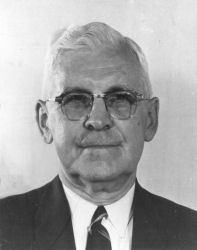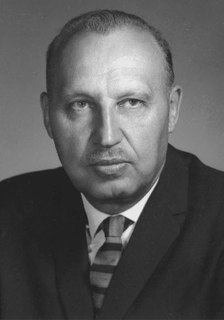 W
WGeorge Edward Pelham Box FRS was a British statistician, who worked in the areas of quality control, time-series analysis, design of experiments, and Bayesian inference. He has been called "one of the great statistical minds of the 20th century".
 W
WRobert Hamilton Coats was Canada's first Dominion Statistician.
 W
WGertrude Mary Cox was an American statistician and founder of the department of Experimental Statistics at North Carolina State University. She was later appointed director of both the Institute of Statistics of the Consolidated University of North Carolina and the Statistics Research Division of North Carolina State University. Her most important and influential research dealt with experimental design; In 1950 she published the book Experimental Designs, on the subject with W. G. Cochran, which became the major reference work on the design of experiments for statisticians for years afterwards. In 1949 Cox became the first woman elected into the International Statistical Institute and in 1956 was President of the American Statistical Association.
 W
WAlbert Ross Eckler served as Deputy Director of the United States Census Bureau from 1949 to 1965, and its Director from 1965 until 1969. He was the first career employee ever to become director of the agency.
 W
WBradley Efron is an American statistician. Efron has been president of the American Statistical Association (2004) and of the Institute of Mathematical Statistics (1987–1988). He is a past editor of the Journal of the American Statistical Association, and he is the founding editor of the Annals of Applied Statistics. Efron is also the recipient of many awards.
 W
WIrving Fisher was an American economist, statistician, inventor, eugenicist and progressive social campaigner. He was one of the earliest American neoclassical economists, though his later work on debt deflation has been embraced by the post-Keynesian school. Joseph Schumpeter described him as "the greatest economist the United States has ever produced", an assessment later repeated by James Tobin and Milton Friedman.
 W
WRichard Fletcher was a member of the United States House of Representatives from Massachusetts. The brother of Governor Ryland Fletcher, he was born in Cavendish, Vermont on January 8, 1788. He pursued classical studies and graduated from Dartmouth College in 1806. He taught school in Salisbury, New Hampshire, studied law, was admitted to the bar and commenced practice there.
 W
WJoseph Adna Hill (1860–1938) was an American statistician, born at Stewartstown, New Hampshire. Hill was descended from "an elite, old-line New England family," and attended many well-regarded educational institutions: after graduating from Phillips Exeter he attended Harvard University, graduating in 1885, and completed his graduate studies at the University of Halle (Ph.D.) in 1892. He published The English Income Tax with Special Reference to Administration and Method of Assessment (1899).
 W
WLeslie Kish was a Hungarian-American statistician and survey methodologist.
 W
WSimon Smith Kuznets was an American economist and statistician who received the 1971 Nobel Memorial Prize in Economic Sciences "for his empirically founded interpretation of economic growth which has led to new and deepened insight into the economic and social structure and process of development."
 W
WRensis Likert was an American social psychologist mainly known for developing the Likert scale, an approach to creating a psychometrically sound scale based on responses to multiple questions or "items." The scale has become a time-honored way to measure people's thoughts and feelings from opinion surveys to personality tests.
 W
WAlfred James Lotka was a US mathematician, physical chemist, and statistician, famous for his work in population dynamics and energetics. An American biophysicist, Lotka is best known for his proposal of the predator–prey model, developed simultaneously but independently of Vito Volterra. The Lotka–Volterra model is still the basis of many models used in the analysis of population dynamics in ecology.
 W
WIsador Lubin was the head of the U.S. Bureau of Labor Statistics from 1933 to 1946, and president of the American Statistical Association in 1946.
 W
WWesley Clair Mitchell was an American economist known for his empirical work on business cycles and for guiding the National Bureau of Economic Research in its first decades.
 W
WCharles Patrick Neill was an American civil servant who raised in Austin, Texas after his family emigrated from Ireland in 1850. Neill graduated from Johns Hopkins University in 1897 with a doctorate in economics and politics. He was appointed the United States Commissioner of Labor in 1906 by President Theodore Roosevelt. As Commissioner of Labor he helped inspect the Meat Packing industries, and reported women and child labor injustices. He also mediated labor disputes between workers and employers in the coal, railroad, and steel corporations.
 W
WJanet Lippe Norwood was an American statistician and the first female Commissioner of the U.S. Bureau of Labor Statistics (BLS) when she was appointed in 1979 by President Jimmy Carter. She was reappointed twice by President Reagan. She left the Bureau in 1991 and joined the Urban Institute as a Senior Fellow, a position she held until 1999. She was also appointed as the Chair of the Advisory Council on Unemployment Compensation, first by President George H. W. Bush in 1993 and then re-elected by President Bill Clinton. She stepped down from that position in 1996. She received numerous awards including several honorary doctorate degrees from academic institutions, including Harvard University.
 W
WRaymond Pearl was an American biologist, regarded as one of the founders of biogerontology. He spent most of his career at Johns Hopkins University in Baltimore. Pearl was a prolific writer of academic books, papers and articles, as well as a committed populariser and communicator of science. At his death, 841 publications were listed against his name.
 W
WMalcolm Churchill Rorty was an American engineer, economist, statistician and manager for the American Telephone and Telegraph Company. He is known as one of the founding members of the Econometric Society, and co-founder of the National Bureau of Economic Research, and in 1931 was elected presidents of the American Statistical Association. Rorty wrote numerous monographs on economic topics in which he opposed an "ultra-conservative viewpoint.", and defended "a laissez-faire approach to business."
 W
WWalter Andrew Shewhart was an American physicist, engineer and statistician, sometimes known as the father of statistical quality control and also related to the Shewhart cycle.
 W
WFrancis Amasa Walker was an American economist, statistician, journalist, educator, academic administrator, and military officer in the Union Army.
 W
WWilson Allen Wallis was an American economist and statistician who served as president of the University of Rochester. He is best known for the Kruskal–Wallis one-way analysis of variance, which is named after him and William Kruskal.
 W
WCarroll Davidson Wright was an American statistician. Wright is best known for his title as the first U.S. Commissioner of Labor, serving in that capacity from 1885 to 1905.
 W
WAllyn Abbott Young was an American economist. He was born into a middle-class family in Kenton, Ohio. He died aged 52 in London, his life cut short by pneumonia during an influenza epidemic. He was then at the height of his intellectual powers and current president of Section F of the British Association. Uniquely, Young had also been president of the American Statistical Association (1917) and the American Economic Association (1925).